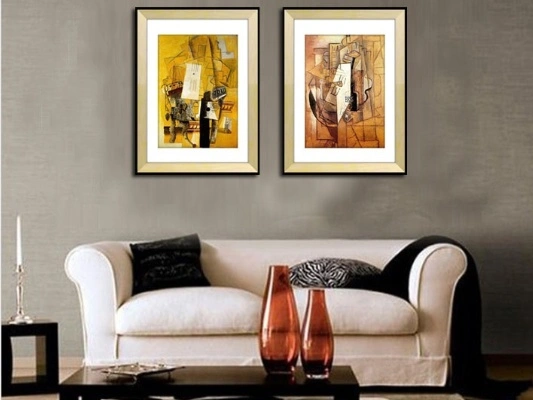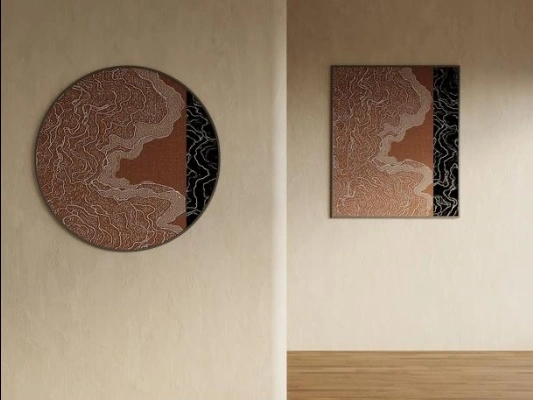What are the components of the infrared semiconductor heating painting?
2025-08-14 17:29:56
Infrared semiconductor heating paintings have been a popular choice in recent years since they look good and can also heat a room. These new gadgets combine traditional art with cutting-edge thermal technology. They may be used to decorate homes and provide extra heat in both residential and commercial environments. To figure out how these paintings work well and securely, you need to take them apart and look at each part separately. Each part has a different job to do to make sure the painting works well, lasts a long time, and makes the user happy. Shengxihong looks at the main parts and groups them into core heating elements, structural and aesthetic carriers, and connective interfaces. He also talks about how they work and how they depend on each other.
Core Heating Elements
At the heart of an infrared semiconductor heating painting lies a set of components responsible for generating and transferring heat. These core elements are engineered to convert electrical energy into infrared radiation, a form of electromagnetic radiation that heats objects directly without warming the surrounding air, ensuring energy efficiency and targeted heating.
The primary component in this category is the semiconductor heating chip, which serves as the thermal generator. These chips are typically made from materials such as barium titanate or silicon-based composites, chosen for their positive temperature coefficient (PTC) properties. PTC materials exhibit a rapid increase in resistance as temperature rises, allowing the chips to self-regulate their heat output and prevent overheating, a critical safety feature. When an electric current passes through the semiconductor material, it excites the electrons, producing infrared radiation in the far-infrared spectrum (typically 5-15 micrometers), which is known for its ability to penetrate materials and provide gentle, uniform heating. The size and number of these chips vary based on the painting's intended heating capacity; larger paintings or those designed for larger spaces may incorporate multiple chips arranged in a grid pattern to ensure even heat distribution.
Complementing the semiconductor chips are conductive wires, which facilitate the transfer of electrical current from the power source to the heating chips. These wires are constructed from high-conductivity materials such as copper or tinned copper, ensuring minimal energy loss during transmission. To meet safety standards, the wires are insulated with heat-resistant materials like silicone rubber or fiberglass, which can withstand temperatures up to 150°C or higher, preventing short circuits and fire risks. The wiring layout is meticulously designed to connect each semiconductor chip in a series or parallel configuration, depending on the desired voltage and current distribution, ensuring that each chip receives a consistent power supply for uniform heating.
The semiconductor heating chips and conductive wires work together to make the infrared semiconductor heating painting work. They also make it safer and more efficient at heating. The design and choice of materials are very important for how long the product will last. For example, high-quality semiconductors and insulated wires can make the gadget last for 50,000 hours or more under regular use conditions.
The second set of parts focuses on housing the core heating elements while also making the product look better and making sure it is structurally sound.

Frames and Canvas
Beyond their heating functionality, infrared semiconductor heating paintings are designed to serve as decorative pieces, requiring components that balance structural support with visual aesthetics. The frame and canvas are two key elements that fulfill this dual role, ensuring the device is both functional and visually pleasing in interior spaces.
The painting frame acts as the primary structural component, providing rigidity and protection to the internal heating elements. Frames are typically crafted from materials such as solid wood, aluminum alloy, or high-density fiberboard (HDF), each offering distinct advantages. Frames made of solid wood, like oak or pine, give a classic, elegant style that works well in traditional settings. Frames made of aluminium alloy, on the other hand, are lightweight, strong, and modern-looking, and they won't rust or warp. HDF frames, often finished with veneers or paints, provide a cost-effective alternative with customizable designs. The frame's dimensions are tailored to the size of the canvas and internal components, with a depth sufficient to accommodate the semiconductor chips and wiring without bulging, ensuring a flat, seamless surface. Additionally, frames may include ventilation slots or heat-dissipating features to prevent heat buildup, though this is minimized by the low surface temperature of semiconductor chips (typically 40-60°C), reducing fire risks and allowing safe placement on walls.
The canvas serves as both the visual medium and a protective layer for the underlying heating elements. Unlike traditional canvases, those used in infrared heating paintings are often made from heat-resistant materials such as polyester or cotton blends treated with flame-retardant coatings. These materials were chosen because they can handle being in moderate heat for a long time without changing colour or breaking down. Using inkjet or sublimation printing, artwork, photos, or decorative patterns are printed on the canvas. This makes sure that the colours are bright and won't fade when they are exposed to heat. In some designs, the canvas is stretched over a rigid backing board (often made from heat-resistant plastic or plywood) to maintain tension and prevent sagging, which could interfere with heat distribution. The canvas also acts as a barrier, preventing dust and debris from accumulating on the semiconductor chips and wires, thereby maintaining heating efficiency over time.
The integration of frame and canvas is critical to the infrared semiconductor heating painting's user experience. A well-designed frame ensures easy installation, often with wall-mounting hardware included, while the canvas's artwork allows the heating painting to blend seamlessly with existing decor, eliminating the need for unsightly heating appliances. This fusion of functionality and aesthetics addresses a key user need: efficient heating that does not compromise interior design.
With the core heating elements protected and aesthetically enhanced by the frame and canvas, the final set of components ensures safe and convenient operation through reliable power connectivity.

Connective Interfaces
To function as a complete system, infrared semiconductor heating paintings require components that facilitate safe and efficient power connectivity, bridging the gap between the internal heating elements and external power sources. The power socket and the wire that goes with it are very important for this since they make sure the user is safe, the device is easy to operate, and it meets electrical regulations.
The power socket is the primary interface between the infrared semiconductor heating painting and the electrical grid, designed to accommodate standard power cords (e.g., Type A/B for North America, Type C/E for Europe). Sockets are typically built into the frame, often at the back or bottom edge, to remain unobtrusive, preserving the painting's aesthetic appeal. They are made of flame-resistant materials like polycarbonate or ABS plastic, which won't melt or catch fire if there is an electrical problem. Many versions include a built-in on/off switch that is part of the socket, which lets users manage the item without having to unhook it, making it more convenient. For added safety, some sockets feature overload protection or thermal fuses that automatically cut off power if the current exceeds safe limits or if the device overheats, mitigating risks of electrical fires.
Wiring integration encompasses the internal connections between the power socket, conductive wires, and semiconductor chips, ensuring a continuous and safe current flow. This includes terminal blocks or connectors that secure wire joints, preventing loose connections that could cause arcing or overheating. The wiring is routed through channels within the frame or backing board, keeping it organized and isolated from the canvas to avoid contact with heat-sensitive materials. Manufacturers often use color-coded wires (e.g., black for live, white for neutral, green for ground) to simplify assembly and ensure compliance with electrical codes, reducing the risk of incorrect wiring during production. Additionally, the entire wiring system is tested for insulation resistance and dielectric strength to meet international standards such as IEC 60335 (for household electrical appliances) or UL 130 (for heating equipment), ensuring reliability across global markets.

Graphene Electric Heating Painting Supplier
Are you tired of traditional heating solutions that are inefficient and lack innovation? Look no further! Shaanxi Shengxihong Science and Technology Co., Ltd., a leading scientific and technological innovation enterprise, is revolutionizing the heating industry with our cutting-edge graphene products.
Our company has independently developed a diverse range of products, including the renowned "Holy Red" stone black electric heating film, graphene electric heating paintings, graphene heaters, graphene clothing, and graphene physiotherapy products. With a modern production base spanning 10,000 square meters and a dedicated team of over 100 professionals, we are committed to delivering high-quality, innovative solutions to our customers.
Our graphene electric heating painting series is a perfect example of our innovation. Choose from a variety of stunning options such as the household graphene metal electric heating painting, graphene metal electrothermal painting, graphene electrothermal oil painting, graphene electrothermal porcelain plate painting, graphene electric heating screen, graphene heating plate, and graphene electrothermal silk painting. These products not only provide efficient heating but also add an artistic touch to your space.
All our products listed for sale come with independent intellectual property rights and patents. We have obtained 17 graphene utility model patents and have been honored with more than 30 awards and certificates at various levels.
Don't miss out on the opportunity to experience the future of heating today! For more information or to place an order, contact us at 1315363763@qq.com. Transform your living and working spaces with Shaanxi Shengxihong Science and Technology Co., Ltd. – where innovation meets excellence.
References
- International Electrotechnical Commission. (2020). IEC 60335-2-30: Household and similar electrical appliances – Safety – Part 2-30: Particular requirements for heating and cooling appliances. Geneva: IEC.
- UL Standards & Engagement. (2019). UL 130: Standard for Safety for Electric Heating Appliances. Northbrook, IL: UL LLC.
- Smith, J., & Johnson, L. (2021). "Semiconductor PTC Heating Elements: Efficiency and Safety in Residential Applications." Journal of Thermal Science and Engineering Applications, 13(4), 041012.
- European Committee for Standardization. (2018). EN 14052: Heating systems in buildings – Method for calculation of system energy efficiency. Brussels: CEN.
- Home Decor Institute. (2022). Integrating Functional Art in Interior Design: A Guide to Heated Decorative Panels. New York: HDI Press.
